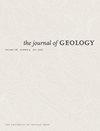Stratigraphy, Depositional Setting, and SHRIMP U-Pb Geochronology of the Banded Iron Formation–Bearing Bailadila Group in the Bacheli Iron Ore Mining District, Bastar Craton, India
IF 1.3
4区 地球科学
Q2 GEOLOGY
引用次数: 2
Abstract
The Bailadila Group of the Bastar Craton, India, is host to a 200-m-thick banded iron formation (BIF). We document the lithostratigraphic context for the BIF, informally referred to as the Bose iron formation, and provide radiometric constraints for its depositional age. Field evidence illustrates that the BIF was deposited on an inner-shelf succession with a quartz arenite that grades upward into the BIF through storm-dominated offshore shelf deposits. The quartz arenite to BIF transition records a relative sea level rise from transgressive to highstand systems tract when the BIFs were deposited in a starved outer continental shelf. U-Pb SHRIMP analyses of zircons from the basement of the Bailadila Group yielded mostly highly discordant U-Pb SHRIMP ages. However, the ages fall on well-defined discordia lines from which concordia intercept ages could be determined. These ages, in combination with the ages of a few zircons that are less than 6% discordant, indicate that the granitoid basement crystallized at 3500–3550 Ma. The maximum depositional age of the Bailadila Group is constrained from the weighted mean 207Pb/206Pb SHRIMP age of 2725±57 Ma from detrital zircons from the basal arenites. A well-constrained weighted mean 207Pb/206Pb SHRIMP age of 2733±53 Ma for zircons from a unit that unconformably overlies the Bailadila Group is within error of that age. Stratigraphic relationships suggest that the Bailadila succession is unconformably overlain by the ~2.5 Ga Kotri and Dongargarh Supergroups. The depositional age of the Bailadila Group is well constrained between ~2.7 and 2.5 Ga. In contrast to most other Archean Algoma-type iron formations of peninsular India, which are closely related to volcanic rocks in greenstone belts, the Bose iron formation is associated with siliciclastic shelf succession. It thus is considered a Superior-type iron formation that represents the oldest known one of its kind in India.印度Bastar Craton Bacheli铁矿矿区含Bailadila群带状铁组的地层、沉积环境和SHRIMP U-Pb地质年代学
印度Bastar克拉通的Bailadila群拥有200米厚的带状铁地层(BIF)。我们记录了BIF的岩石地层背景,非正式地称为Bose铁组,并提供了其沉积时代的辐射限制。现场证据表明,BIF沉积在陆架内部序列上,石英砂岩通过风暴主导的海上陆架沉积向上分级进入BIF。石英砂质岩向BIF的转变记录了BIF沉积于饥饿的外大陆架时,海平面从海侵体系域到高水位体系域的相对上升。巴拉迪拉群基底锆石U-Pb SHRIMP年龄分析结果显示,大部分锆石U-Pb SHRIMP年龄高度不一致。然而,年龄落在明确的不协和线上,从中可以确定协和线的截距年龄。结合部分锆石年龄不一致小于6%,表明花岗岩基底在3500 ~ 3550 Ma发生结晶。根据基岩砂质碎屑锆石的加权平均207Pb/206Pb SHRIMP年龄(2725±57 Ma),确定了巴拉迪拉群的最大沉积年龄。不整合上覆于Bailadila群上的锆石207Pb/206Pb SHRIMP加权平均年龄(2733±53 Ma)在该年龄的误差范围内。地层关系表明,巴拉迪拉演替被~2.5 Ga Kotri超群和Dongargarh超群不整合覆盖。巴拉迪拉群的沉积年龄限定在~2.7 ~ 2.5 Ga之间。与印度半岛大多数与绿岩带火山岩密切相关的太古宙阿尔戈马型铁组不同,玻色铁组与硅-碎屑陆架演替有关。因此,它被认为是一个上等型铁地层,代表了印度已知的最古老的铁地层。
本文章由计算机程序翻译,如有差异,请以英文原文为准。
求助全文
约1分钟内获得全文
求助全文
来源期刊

Journal of Geology
地学-地质学
CiteScore
3.50
自引率
5.60%
发文量
0
审稿时长
3 months
期刊介绍:
One of the oldest journals in geology, The Journal of Geology has since 1893 promoted the systematic philosophical and fundamental study of geology.
The Journal publishes original research across a broad range of subfields in geology, including geophysics, geochemistry, sedimentology, geomorphology, petrology, plate tectonics, volcanology, structural geology, mineralogy, and planetary sciences. Many of its articles have wide appeal for geologists, present research of topical relevance, and offer new geological insights through the application of innovative approaches and methods.
 求助内容:
求助内容: 应助结果提醒方式:
应助结果提醒方式:


